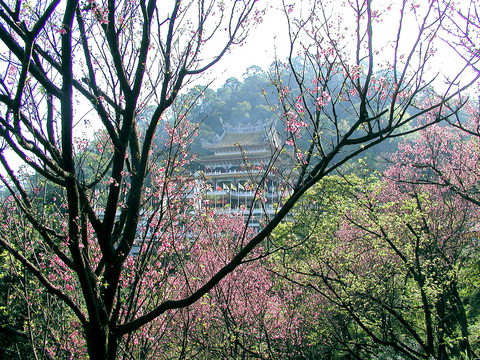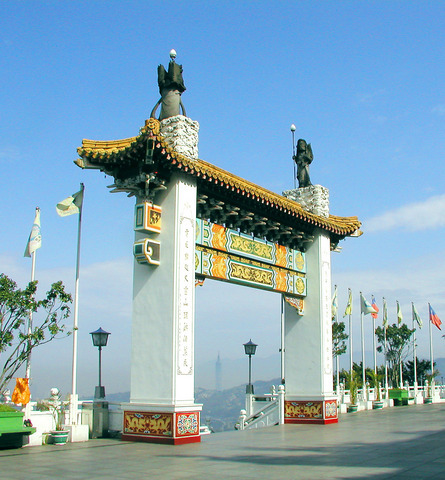One of Taipei's greatest advantages is that when the need to get away from it all becomes overwhelming, then hopping on the right city bus will usually do the trick to leave the hustle and bustle behind and soak in a bit of nature. That was my objective on a recent weekend: to escape the city using only city buses, and Muzha, I discovered, is the ideal place to do just that.
At the southern edge of Taipei City, Muzha can feel at times light years away from the cosmopolitan glass-and-steel vertical jungle of downtown, though they are, in fact, only a few kilometers apart. The district, with its narrow roads, elderly population and the predominance of Taiwanese over Mandarin being spoken, feels almost like a southern rural village roped into the city. New modern high-rise apartments springing up suggest Muzha may yet be fully co-opted into the city, but for now, its mostly squat, humble apartment blocks provide some human scale to neighborhoods and views of the nearby hills that form the southern rim of Taipei's basin. And from almost every point in Muzha one can see the imposing Chi-nan Temple (指南宮) perched atop the mountain for which the temple is named.
Aside from being a major worship location for Daoism in Taiwan, Chi-nan Temple is also the nexus of a network of hiking and biking trails that spreads out over the hills from Nangang on the eastern edge of Taipei all the way southwest to Sindian. Starting in Gongguan, the 530 bus runs directly to the temple, from where a coin toss can decide whether to head in the direction of Shenkeng to the northwest, or through the tea farms of Maokong and eventually over the hills and into Sindian. My coin told me Sindian.

Magical Maokong
From Chi-nan Temple, a quick stroll along the road out the back of the complex leads to Maokong, formerly one of the main tea-producing centers of northern Taiwan that was allegedly named for the holes worn into the valley's streambed that locals said looked as though they had been dug by a cat. Things have changed considerably since the area's tea-producing heyday in the late 19th century, as most of the farmers on the mountain have long since given themselves over to the lucrative restaurant and teahouse businesses that attract car-driving throngs on weekends.
For this reason, hiking through Maokong is best enjoyed well before noon on weekends to avoid fleets of aggressive drivers on the winding, narrow mountain roads. Most of the hiking, however, can be done off paved roads and on established trails trod down by intrepid contingents of mountain bikers and teams of senior citizens who can be seen hiking in orderly rows zigzagging up and down the hills in the morning hours.

From Chi-nan Temple, following the Dacheng Dian trail and then linking up with the Taipei Tea Promotion Center Trail, the leisurely hiker can reach this small but interesting exhibition center in about an hour. The center features displays of Taiwan's various strains of teas, tools and machinery used in tea production and an informative multi-lingual audio-visual introduction to the history of tea production in the area. Guides from the Liu-kung Agricultural Foundation are on hand, as well, to offer introductions in Chinese and English to the center's displays and to the history of tea production in Wenshan. Open on weekends, comfortably air-conditioned and always ready to offer free cups of locally produced Tieh Kuan-yin Tea, this is understandably a popular resting spot for hikers passing through Maokong. Other options for a respite or food, or both in my case, include any of the scores of teahouses that line the road that snakes its way up the mountainside.
Cave exploring
Plenty of tea is still produced in Maokong by holdout farmers and the remainder of the hike to Sindian passes through the more picturesque of their fields, at its higher elevations, with arresting views of Taipei and, of course, Taipei 101 providing some postcard juxtapositions.

So after enjoying far too much of the tea-leaf fried rice, tea-leaf fried veggies and tea jelly and drinking too much Tieh Kuan-yin tea in Maokong, it was high time on my visit to burn off some calories by hitting the small trail that leads over the hill through an isolated glen of vegetable and tea fields to one of the best-hidden temples in Taipei. Tucked partially behind a waterfall, Yinhe Cave Temple is a tiny Buddhist structure carved mid-way up a 50m cliff that enjoys a spot in local lore for being a weapons depot for resistance fighters against the Japanese occupation at the beginning of the last century. In fact, many of the hiking trails that still exist in the area were once used by Shenkeng-based guerillas fighting the Japanese and some of the nearby peaks were used to send signals about Japanese troop movements.
I had been told that after heavy rains, Yinhe Temple becomes concealed by falling water, but scarce rain this season has left most of the temple exposed. That was a bit of a let-down because the temple itself is a rather bland concrete slab. But the reduced waterfall, nonetheless, is quite spectacular, dumping over its precipice in a jungle setting ringed by blazing pink and white azaleas that are now in bloom. A flat, concrete viewing area next to the base of the falls is a perfect picnic setting in dry conditions.
Having trekked from Chih-nan Temple, down and up one valley to Maokong and over one ridge to the waterfall, I had begun to feel that such an outing held its share of adventure. But my bubble was burst when a chipper family with hip-high toddlers in tow came into view on the last stretch of road that leads out to National Route 9 running from Ilan to Sindian. The colors of the forest, the hush of swaying bamboo groves, the sight of old men tilling fields had all led me to believe I had traveled great distances and left most of what was familiar behind. But no, it's just a family hiking trail only one quick corner out of sight from the city. I turned that corner by walking a final kilometer along Route 9 into Sindian and catching the 650 bus back to Gongguan feeling refreshed all the same.

This month the government ordered a one-year block of Xiaohongshu (小紅書) or Rednote, a Chinese social media platform with more than 3 million users in Taiwan. The government pointed to widespread fraud activity on the platform, along with cybersecurity failures. Officials said that they had reached out to the company and asked it to change. However, they received no response. The pro-China parties, the Chinese Nationalist Party (KMT) and Taiwan People’s Party (TPP), immediately swung into action, denouncing the ban as an attack on free speech. This “free speech” claim was then echoed by the People’s Republic of China (PRC),

Exceptions to the rule are sometimes revealing. For a brief few years, there was an emerging ideological split between the Democratic Progressive Party (DPP) and Chinese Nationalist Party (KMT) that appeared to be pushing the DPP in a direction that would be considered more liberal, and the KMT more conservative. In the previous column, “The KMT-DPP’s bureaucrat-led developmental state” (Dec. 11, page 12), we examined how Taiwan’s democratic system developed, and how both the two main parties largely accepted a similar consensus on how Taiwan should be run domestically and did not split along the left-right lines more familiar in

As I finally slid into the warm embrace of the hot, clifftop pool, it was a serene moment of reflection. The sound of the river reflected off the cave walls, the white of our camping lights reflected off the dark, shimmering surface of the water, and I reflected on how fortunate I was to be here. After all, the beautiful walk through narrow canyons that had brought us here had been inaccessible for five years — and will be again soon. The day had started at the Huisun Forest Area (惠蓀林場), at the end of Nantou County Route 80, north and east

Specialty sandwiches loaded with the contents of an entire charcuterie board, overflowing with sauces, creams and all manner of creative add-ons, is perhaps one of the biggest global food trends of this year. From London to New York, lines form down the block for mortadella, burrata, pistachio and more stuffed between slices of fresh sourdough, rye or focaccia. To try the trend in Taipei, Munchies Mafia is for sure the spot — could this be the best sandwich in town? Carlos from Spain and Sergio from Mexico opened this spot just seven months ago. The two met working in the